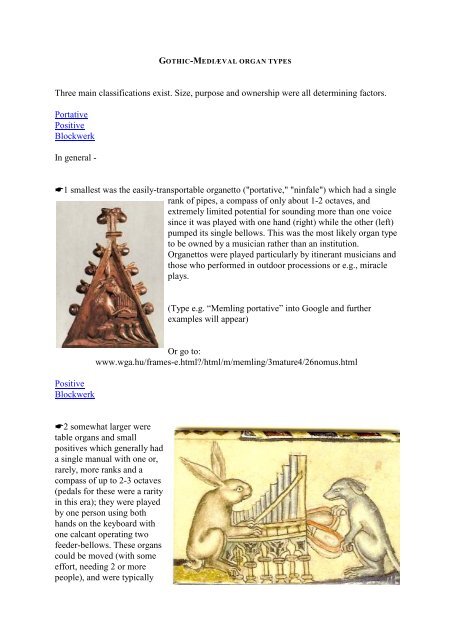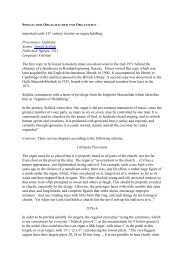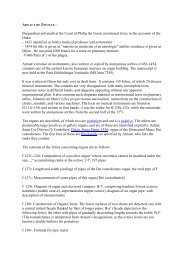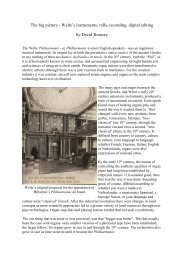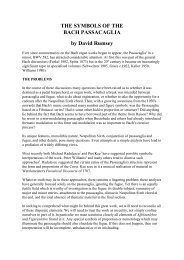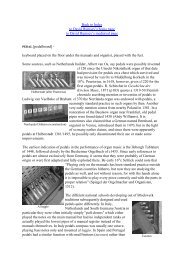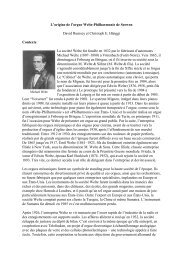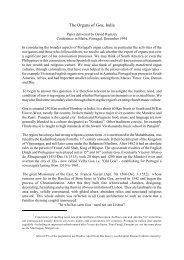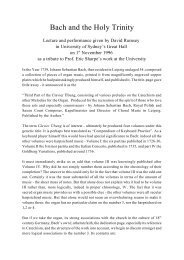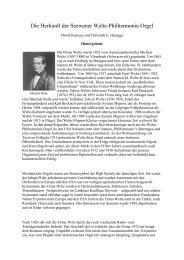medieval organ types - David Rumsey
medieval organ types - David Rumsey
medieval organ types - David Rumsey
Create successful ePaper yourself
Turn your PDF publications into a flip-book with our unique Google optimized e-Paper software.
GOTHIC-MEDIÆVAL ORGAN TYPES<br />
Three main classifications exist. Size, purpose and ownership were all determining factors.<br />
Portative<br />
Positive<br />
Blockwerk<br />
In general -<br />
1 smallest was the easily-transportable <strong>organ</strong>etto ("portative," "ninfale") which had a single<br />
rank of pipes, a compass of only about 1-2 octaves, and<br />
extremely limited potential for sounding more than one voice<br />
since it was played with one hand (right) while the other (left)<br />
pumped its single bellows. This was the most likely <strong>organ</strong> type<br />
to be owned by a musician rather than an institution.<br />
Organettos were played particularly by itinerant musicians and<br />
those who performed in outdoor processions or e.g., miracle<br />
plays.<br />
(Type e.g. “Memling portative” into Google and further<br />
examples will appear)<br />
Positive<br />
Blockwerk<br />
Or go to:<br />
www.wga.hu/frames-e.html?/html/m/memling/3mature4/26nomus.html<br />
2 somewhat larger were<br />
table <strong>organ</strong>s and small<br />
positives which generally had<br />
a single manual with one or,<br />
rarely, more ranks and a<br />
compass of up to 2-3 octaves<br />
(pedals for these were a rarity<br />
in this era); they were played<br />
by one person using both<br />
hands on the keyboard with<br />
one calcant operating two<br />
feeder-bellows. These <strong>organ</strong>s<br />
could be moved (with some<br />
effort, needing 2 or more<br />
people), and were typically
found in the residences of the wealthy, sometimes played by well-bred ladies. They were not<br />
normally owned by the musicians who played them.<br />
Portative<br />
Blockwerk<br />
3 the largest were the Blockwerks that were permanently installed, typically in swallow's<br />
nest or gallery situations. They had multiple ranks -<br />
from 3 or 4, sometimes up to around 50 -<br />
compasses of 2-3 or more octaves and went through<br />
a process of stop-separation commencing around<br />
th<br />
early 15 c. One player could use both hands, or<br />
even feet where pedals were provided, and thus<br />
play two or possibly more parts (up to 10 parts from<br />
2 hands and 2 feet on the <strong>organ</strong>s which had<br />
developed out of them by the time of Schlick in<br />
th<br />
early 16 c). They often required many calcants, e.g.<br />
26 bellows needing an (allegorical?) "70 strong<br />
men" at Winchester c994, or around 20 bellows/20<br />
calcants at Halberstadt in 1361 according to M.<br />
Praetorius. These <strong>organ</strong>s were mostly owned by<br />
well-endowed churches, monasteries and<br />
sometimes also the private chapels of the wealthy<br />
(such as the Duc de Berry at Bourges). They were<br />
normally played by religious and never owned by<br />
musicians.<br />
It is sometimes conjectured that the Rückpositiv<br />
may have evolved from the convenient placing of a<br />
positive in a gallery alongside a Blockwerk (first<br />
divisions of this name were identified around<br />
1455/1458 at Delft, Oude Kerk and Zwolle, Onze<br />
Lieve Vrouw also in 1455).<br />
Portative<br />
Positive<br />
Blockwerk<br />
............<br />
And in case your were wondering ... animals playing the <strong>organ</strong>?


